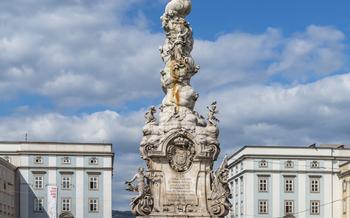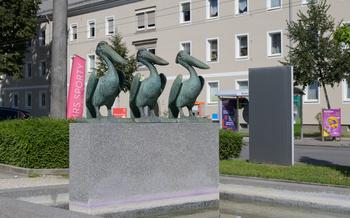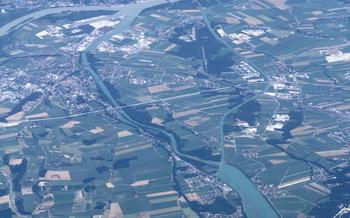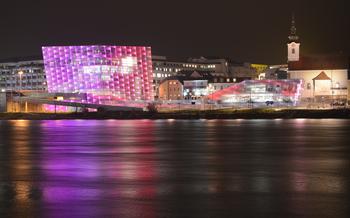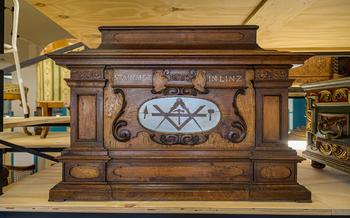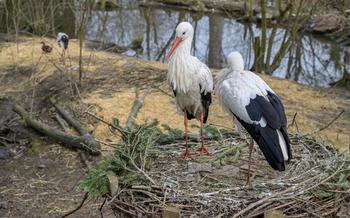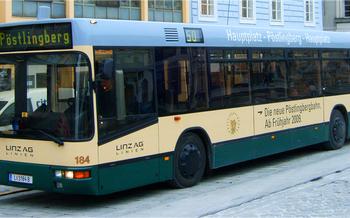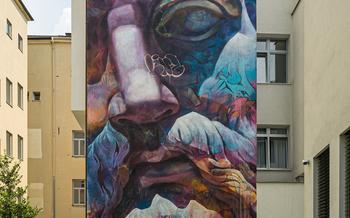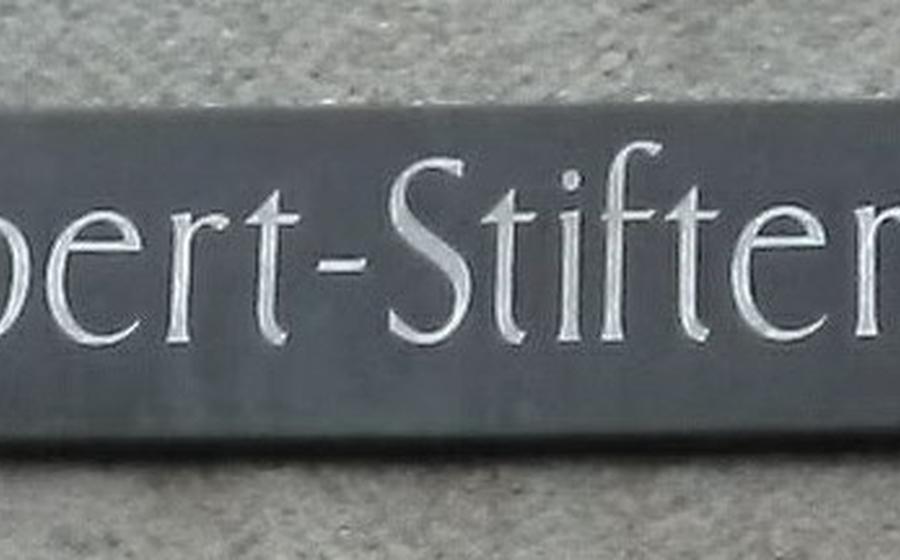
Adalbert Stifter Platz
- The Rebirth of Linz:
- The Trinity Column
- The New Cathedral (Neuer Dom)
- The Ars Electronica Center
- The Lentos Art Museum
- The Landestheater Linz
- The Pöstlingbergbahn: A Scenic Journey to the Top
- The Botanical Garden (Botanischer Garten)
- The Zoo Linz: A Haven for Animal Lovers
- The Danube River
- Personal Anecdote
- The Hauptplatz: The Heart of Linz
- The Schlossmuseum Linz: A Journey Through History
The Rebirth of Linz:
Linz, once a prominent industrial hub, has undergone a remarkable transformation, emerging as a vibrant cultural center. This metamorphosis was catalyzed by Linz's designation as the European Capital of Culture in 2009, propelling the city into the spotlight and attracting international attention. The city embraced this opportunity, investing heavily in arts, culture, and urban development, resulting in a thriving cultural scene that has become an integral part of Linz's identity.
I vividly recall my first visit to Linz, shortly after it had been bestowed with the title of European Capital of Culture. The city emanated an electrifying energy, its streets abuzz with cultural events, exhibitions, and performances. The atmosphere was palpable, as if the city was pulsating with a newfound vitality. Linz had truly embraced its cultural renaissance, and it was evident that the designation had left an enduring impact.
The Trinity Column
The Trinity Column, towering majestically in the heart of Adalbert Stifter Platz, is a testament to Linz's rich religious heritage. Erected in 1723 amidst the turmoil of the bubonic plague, the column stands as a symbol of gratitude and devotion. Its intricate sculptures, a masterpiece of Baroque artistry, depict the Holy Trinity, the Virgin Mary, and a host of saints, each rendered with exquisite detail and symbolism.
The column's base features reliefs narrating the story of the plague and the subsequent vow made by Linz's citizens to construct this monument as an expression of their gratitude for divine protection. The central figure of the Holy Trinity, adorned with a crown and scepter, represents God's sovereignty and benevolence. The Virgin Mary, depicted with a halo and a gentle smile, symbolizes compassion and intercession.
Surrounding the Holy Trinity are sculptures of saints, each representing a specific virtue or role. Saint Sebastian, pierced by arrows, embodies courage and resilience in the face of adversity. Saint Roch, with a dog at his feet, is the patron saint of plague victims, a poignant reminder of the suffering endured during the epidemic. Saint Florian, with a bucket of water, symbolizes protection against fire, a constant threat in a city with many wooden buildings.
The Trinity Column is not merely a religious monument but also a work of art that reflects the Baroque era's fascination with intricate ornamentation and symbolism. Its sculptures, carved from white limestone, are a testament to the skill and artistry of the Baroque masters. The column's grandeur and beauty make it a focal point of Adalbert Stifter Platz, inviting visitors to pause and admire its exquisite craftsmanship and the stories it tells.
The New Cathedral (Neuer Dom)
The New Cathedral, also known as Mariendom, stands as a testament to Linz's religious and cultural heritage. Constructed between 1862 and 1924, the cathedral showcases a captivating blend of Gothic and Neo-Gothic architectural styles. Its twin spires, reaching towards the heavens, dominate the city's skyline, symbolizing Linz's spiritual grandeur.
The interior of the New Cathedral is equally awe-inspiring, adorned with intricate stained-glass windows that depict biblical scenes and celestial figures. The vibrant colors cast a warm glow, creating a serene and contemplative atmosphere. The high altar, meticulously carved from marble, serves as a focal point, drawing the eye with its intricate details and artistry.
Beyond its religious significance, the New Cathedral holds a special place in Linz's cultural landscape. It serves as a venue for concerts, exhibitions, and other cultural events, showcasing the city's vibrant artistic scene. Attending a concert within the cathedral's hallowed walls is an experience like no other, as the music reverberates through the grand space, creating an unforgettable symphony of sound and spirit.
The Ars Electronica Center
At the heart of Linz's cultural landscape lies the Ars Electronica Center, a pioneering institution dedicated to the exploration of art, technology, and society's ever-evolving relationship. Founded in 1996, this visionary center has established itself as a global hub for digital arts, pushing the boundaries of creativity and innovation.
The Ars Electronica Center's mission is to foster a deeper understanding of the impact of technology on our lives, encouraging critical reflection and inspiring new perspectives. Through a diverse range of interactive exhibits, installations, and events, the center invites visitors to engage with cutting-edge technologies and explore their potential to shape our future.
Step into the center's immersive world, and you'll be greeted by a symphony of interactive experiences. Explore the boundaries of virtual reality, immerse yourself in mesmerizing digital art installations, and engage with thought-provoking exhibitions that challenge your perceptions of reality. The center's innovative approach to storytelling blends art, science, and technology, creating a truly unique and unforgettable experience.
One particularly captivating exhibit is the Deep Space 8K, a state-of-the-art projection system that transports visitors to distant galaxies, microscopic worlds, and breathtaking natural landscapes. With its 16-meter-wide screen and crystal-clear 8K resolution, Deep Space 8K offers an unparalleled immersive experience that will leave you in awe.
The Ars Electronica Center is not just a museum; it's a dynamic platform for experimentation, collaboration, and discourse. Throughout the year, the center hosts a variety of events, workshops, and conferences that bring together artists, scientists, technologists, and innovators from around the world. These events provide a vibrant forum for exchanging ideas, fostering creativity, and shaping the future of digital culture.
Visiting the Ars Electronica Center is an absolute must for anyone interested in the intersection of art, technology, and society. Prepare to be amazed, inspired, and challenged as you embark on a journey into the digital realm at this groundbreaking institution.
The Lentos Art Museum
Standing proudly on the banks of the Danube River, the Lentos Art Museum is an architectural marvel that houses a treasure trove of modern and contemporary art. Its striking glass and steel structure, reminiscent of a beached ship, seamlessly blends into the cityscape, creating a captivating contrast between old and new.
Inside, visitors are greeted by a world of artistic wonders, where thought-provoking paintings, sculptures, installations, and multimedia displays converge. The museum's collection boasts masterpieces from renowned Austrian and international artists, including Gustav Klimt, Egon Schiele, Andy Warhol, and Ai Weiwei.
Temporary exhibitions and events add to the Lentos Art Museum's dynamic atmosphere, showcasing the latest trends and innovations in the art world. From immersive video installations to interactive digital experiences, the museum offers a platform for artists to challenge conventions and push creative boundaries.
My personal encounter with the Lentos Art Museum was nothing short of transformative. As I wandered through the galleries, I was captivated by the sheer diversity and ingenuity of the artworks on display. One piece that particularly resonated with me was a mesmerizing video installation that explored the concept of identity through a series of fragmented narratives. The artist's skillful use of light, sound, and movement created a visceral experience that left me both contemplative and inspired.
The Lentos Art Museum is not just a repository of art; it is a vibrant hub where creativity flourishes and dialogues are sparked. Its unique architecture, coupled with its exceptional collection and innovative exhibitions, makes it a must-visit destination for any art enthusiast exploring Linz.
The Landestheater Linz
The Landestheater Linz, founded in 1803, is a cultural jewel nestled in the heart of Linz. This stunning neoclassical edifice, designed by renowned architect Franz Jäger, has graced the city's Theaterplatz for over two centuries. Its majestic facade, adorned with intricate carvings and sculptures, hints at the captivating performances that await within.
Step inside the Landestheater Linz, and you'll be transported to a world of artistic excellence. The theater's grand auditorium, with its plush red seats and ornate chandeliers, creates an atmosphere of elegance and grandeur. Its stage has witnessed countless unforgettable performances, from classical operas and ballets to contemporary theater productions.
The Landestheater Linz is renowned for its diverse repertoire, showcasing a wide range of productions that cater to every taste. Whether you're a fan of traditional opera or prefer the thrill of modern dance, the theater's programming is sure to offer something to captivate you.
Beyond its artistic achievements, the Landestheater Linz plays a vital role in promoting local talent. The theater actively supports emerging artists and provides a platform for them to showcase their skills. Its commitment to nurturing homegrown talent has helped Linz establish itself as a thriving hub for the performing arts.
Personal Experience:
My visit to the Landestheater Linz was an evening of pure enchantment. I had the privilege of attending a performance of Mozart's beloved opera, The Marriage of Figaro. The production was nothing short of spectacular, with stunning sets, vibrant costumes, and exquisite vocals. The entire cast exuded passion and talent, bringing the timeless story to life before my eyes.
As the final curtain fell, I left the theater with a sense of awe and inspiration. The Landestheater Linz had once again proven its status as a cultural powerhouse, delivering an unforgettable performance that will forever hold a special place in my memory.
The Pöstlingbergbahn: A Scenic Journey to the Top
Amidst the many attractions that Linz has to offer, the Pöstlingbergbahn stands out as a unique and unforgettable experience. This historic mountain railway, built in 1898, takes passengers on a leisurely journey up the Pöstlingberg hill, offering breathtaking views of the city and the surrounding countryside.
The Pöstlingbergbahn is a marvel of engineering, with its steep inclines and sharp curves. The train's vintage carriages, with their wooden benches and brass fittings, add to the charm of the experience. As the train slowly ascends the hill, passengers can enjoy panoramic views of Linz's rooftops, the Danube River, and the distant Alps.
At the summit of Pöstlingberg, visitors are rewarded with stunning vistas that stretch for miles in every direction. The observation deck offers a bird's-eye view of Linz and its surroundings, making it a popular spot for photographers and nature enthusiasts.
For those seeking a truly unique experience, the Grottenbahn, a subterranean railway, connects the Pöstlingbergbahn to the Grottenburg, a former castle turned into a restaurant and event venue. The Grottenbahn, with its dimly lit tunnels and eerie atmosphere, is a fascinating attraction in its own right.
My personal experience on the Pöstlingbergbahn was nothing short of magical. As the train climbed the hill, I couldn't help but marvel at the engineering feat that made this journey possible. The panoramic views from the summit were simply breathtaking, and I felt a sense of awe as I looked out over the city and its surroundings.
Whether you're a history buff, a nature lover, or simply someone who appreciates stunning views, the Pöstlingbergbahn is an attraction that should not be missed. This iconic mountain railway is a testament to Linz's rich heritage and its commitment to preserving its natural beauty.
The Botanical Garden (Botanischer Garten)
Linz's Botanical Garden, a haven for nature lovers, showcases a diverse collection of plants and flowers from across the globe. Established in 1839, the garden has grown into a sprawling green oasis, offering visitors a tranquil escape within the city limits.
The garden is meticulously divided into various sections, each representing a distinct ecosystem or geographical region. From the lush tropical greenhouse, brimming with exotic flora, to the serene Japanese garden, with its carefully manicured landscapes, visitors can embark on a botanical journey around the world.
Beyond its aesthetic appeal, the Botanical Garden serves as an important center for research and education. It hosts workshops, guided tours, and educational programs, providing visitors with insights into the fascinating world of plants and their ecological significance.
In spring, the garden transforms into a vibrant tapestry of colors as thousands of tulips, daffodils, and hyacinths burst into bloom. The summer months bring forth a profusion of roses in the dedicated rose garden, while the autumn foliage paints the landscape in warm hues of gold and crimson.
My personal experience at the Botanical Garden was nothing short of enchanting. As I wandered through the various sections, I was captivated by the sheer diversity of plant life.
The Zoo Linz: A Haven for Animal Lovers
The Zoo Linz is an enchanting oasis nestled within the vibrant city of Linz. Founded in 1975, the zoo is home to over 600 animals representing more than 100 species from around the world. Situated on a sprawling 10-hectare site, the Zoo Linz is a haven for animal lovers and families seeking an educational and awe-inspiring experience.
The zoo's mission is twofold: to promote animal welfare and conservation, and to educate visitors about the importance of biodiversity. The Zoo Linz is actively involved in numerous conservation projects, including breeding programs for endangered species such as the Amur leopard and the Sumatran tiger. Through its educational programs, workshops, and guided tours, the zoo aims to raise awareness about animal behavior, ecology, and the threats facing wildlife in the wild.
Visitors to the Zoo Linz are treated to a diverse array of animal encounters. From majestic lions and playful monkeys to graceful giraffes and colorful birds, the zoo offers a glimpse into the fascinating world of wildlife. The enclosures are thoughtfully designed to replicate the animals' natural habitats, ensuring their well-being and providing visitors with an immersive experience.
One of the highlights of the Zoo Linz is the opportunity to observe the animals up close during feeding time. Knowledgeable zookeepers provide informative commentary, sharing insights into the animals' diets and behaviors. Children will delight in the interactive exhibits, where they can learn about animal anatomy, habitats, and conservation efforts.
My personal experience at the Zoo Linz was truly unforgettable. I was particularly captivated by the playful antics of the red pandas and the mesmerizing beauty of the snow leopards. The zoo's commitment to animal welfare and conservation was evident in every aspect of the experience, leaving me with a deep appreciation for the incredible diversity of life on Earth.
Practical Information:
- Address: Zoo Linz, Auhof 1, 4040 Linz, Austria
- Opening Hours: Daily from 9:00 AM to 6:00 PM
- Admission Fees: Adults: €50, Children (6-15 years): €50, Children under 6 years: free
- Website: Zoo Linz
The Danube River
The mighty Danube River, Europe's second-longest river, flows through the heart of Linz, adding to the city's charm and allure. The Danube has played a pivotal role in shaping Linz's history and economy, serving as a vital trade route and a source of sustenance for centuries.
The riverbank in Linz is a vibrant hub of activity, with locals and visitors alike enjoying leisurely walks, bike rides, or simply relaxing while soaking in the picturesque views. The Danube also offers a variety of recreational opportunities, such as boat trips, kayaking, and fishing, allowing visitors to experience the river's natural beauty up close.
One of the highlights of Linz's Danube River experience is the annual Linz Donau Festival, a spectacular celebration of music, art, and culture held on floating stages along the river. This vibrant festival attracts thousands of visitors each year, who come to enjoy performances by renowned musicians, artists, and performers from around the world.
Personal Anecdote
During my visit to Linz, I couldn't resist the allure of the Danube River. I embarked on a leisurely stroll along the well-maintained riverbank, marveling at the stunning views of the city's skyline and the lush green hills beyond. The gentle breeze carried the sound of birdsong and the distant hum of the city, creating a serene and tranquil atmosphere.
As I strolled along the river, I stumbled upon a charming cafe with outdoor seating overlooking the Danube. I decided to indulge in a slice of delicious Linzer torte and a cup of Viennese coffee while savoring the picturesque views. It was the perfect way to relax and soak in the beauty of Linz's riverside oasis.
The Hauptplatz: The Heart of Linz
The Hauptplatz, or Main Square, is the beating heart of Linz. This historic square has witnessed countless events throughout the city's rich history and remains a vibrant hub of activity to this day.
The architectural ensemble surrounding the Hauptplatz is a testament to Linz's diverse past. The eye-catching Altes Rathaus, with its Gothic facade and Renaissance courtyard, stands as a reminder of the city's medieval origins. In stark contrast, the modern and sleek Volkshaus building, with its glass and steel facade, symbolizes Linz's transformation into a modern industrial center.
Every Saturday, the Hauptplatz transforms into a bustling marketplace, where local farmers and vendors gather to sell their fresh produce, handmade crafts, and regional delicacies. The air fills with the aroma of freshly baked bread, sweet pastries, and hearty sausages, creating a lively and vibrant atmosphere that is not to be missed.
Amidst the hustle and bustle of the market, visitors can find respite in one of the many cafes or restaurants that line the square. Whether you prefer to sip on a frothy cappuccino while people-watching or indulge in a traditional Austrian meal at a cozy tavern, the Hauptplatz offers culinary experiences to suit every taste.
My personal experience of the Hauptplatz was during the annual Linzfest, a lively festival that takes over the city for a week each summer. The square was transformed into a stage for musicians, dancers, and performers from around the world, creating an electric atmosphere that had me dancing in the streets until the wee hours of the morning.
The Hauptplatz is a must-visit destination for anyone exploring Linz. Whether you're a history buff, a foodie, or simply someone who enjoys soaking up the local atmosphere, this vibrant square has something to offer everyone.
The Schlossmuseum Linz: A Journey Through History
Nestled atop the picturesque Schlossberg hill, overlooking the vibrant city of Linz, stands the majestic Linz Castle, home to the captivating Schlossmuseum Linz. This architectural masterpiece, with its imposing towers and intricate Renaissance-style details, is a testament to the city's rich history and cultural heritage.
Within the castle's grand walls lies a treasure trove of artifacts, artworks, and historical exhibits that narrate the captivating story of Linz's past. From prehistoric settlements to the Roman era, the museum takes visitors on a journey through the ages, showcasing the city's evolution from a humble village to a thriving industrial and cultural hub.
One of the highlights of the Schlossmuseum is its impressive collection of medieval armor and weapons, providing a glimpse into the city's martial history. Visitors can marvel at the intricate craftsmanship of swords, helmets, and suits of armor that once protected Linz's brave warriors.
Another captivating exhibit showcases the city's artistic heritage, featuring works by renowned local artists from the Renaissance to the modern era. From delicate watercolors depicting Linz's charming landscapes to bold, abstract sculptures that challenge conventional notions of art, the museum offers a diverse and thought-provoking exploration of Linz's creative spirit.
For those seeking panoramic vistas, the Schlossmuseum's observation tower beckons, offering breathtaking views of the city and the surrounding countryside. From this vantage point, visitors can admire the meandering Danube River, the lush green hills, and the cityscape's architectural landmarks, creating lasting memories of Linz's beauty.
My personal experience at the Schlossmuseum was nothing short of awe-inspiring. As I wandered through the castle's grand halls, I felt transported back in time, immersing myself in the captivating stories of Linz's past. The exhibits were meticulously curated, providing a comprehensive and engaging journey through history.
The highlight of my visit was discovering a hidden gem within the museum's collection—a beautifully preserved 16th-century tapestry depicting a vibrant festival scene in Linz. The intricate details and vibrant colors of the tapestry brought the past to life, allowing me to imagine the city's bustling streets and lively celebrations of centuries ago.
If you seek a deeper understanding of Linz's rich heritage, the Schlossmuseum Linz is an absolute must-visit. Its captivating exhibits, stunning views, and knowledgeable staff will transport you to another era, leaving you with a profound appreciation for this vibrant city's history and cultural treasures.
